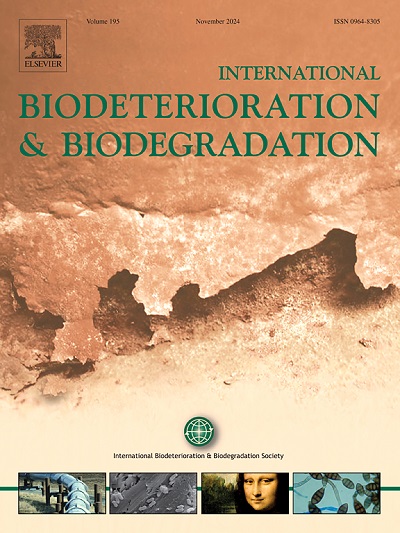Enrichment of methanotrophic consortium and its aerobic cometabolism of mixed vinyl chloride pollutants using methane gas and micro- and nano-bubbles
IF 4.1
2区 环境科学与生态学
Q2 BIOTECHNOLOGY & APPLIED MICROBIOLOGY
International Biodeterioration & Biodegradation
Pub Date : 2025-02-01
DOI:10.1016/j.ibiod.2025.106011
引用次数: 0
Abstract
Chlorinated ethylenes (CEs) are widely used in various industries, making them common groundwater pollutants. The reductive dechlorination applied to deal with CEs has the drawback of lower-chlorinated CEs accumulation. Aerobic co-metabolism relying on methanotrophs is an attractive strategy to deal with CEs because of its fast CE degrading rate and no lower-chlorinated CEs accumulation. In this study, one methanotrophic consortium was acclimated with methane and TCE concentrations for five phases. The bacterial community and methane monooxygenase (MMO) functional genes were analyzed during enrichment. The methane gas and micro-nano bubbles (MNBs) were applied to perform batch experiments using the acclimated methanotrophic consortium as the inoculum. The results indicated that a methanotrophic consortium M-5%-0.2 was successfully acclimated. Genus Methylocystis was dominant in the acclimated consortium M-5%-0.2, and the particulate methane monooxygenase gene (pmoA) could be detected. With different CEs combinations and 5% methane gas, 0.2 and 0.3 mg/L cis-1,2-DCE and VC could be entirely removed. TCE removal efficiencies were 38.8% and 40.2%, as the TCE concentrations were 0.2 and 0.3 mg/L, respectively. CEs removal pattern was similar in the presence of various methane MNBs ratios. The priority order of CEs removal was VC > cis-1,2-DCE > TCE. The degradation efficiencies of 0.2 mg/L TCE, cis-1,2-DCE, and VC were 17.4%, 78.4%, and 100% when adding 24% methane MNBs water as the carbon source. The methanotrophic consortium M-5%-0.2 could utilize the methane MNBs having a diameter larger than 235 nm. In conclusion, the aerobic co-metabolism strategy using methane MNBs has the potential to be applied for CEs bioremediation.

利用甲烷气体和微纳米气泡富集甲烷营养化联合体及其混合氯乙烯污染物的好氧共代谢
氯代乙烯(CEs)广泛应用于各行各业,是常见的地下水污染物。应用还原脱氯法处理铯具有低氯化铯积累的缺点。依靠甲烷氧化菌的有氧共代谢是一种有吸引力的处理碳排放化合物的策略,因为它的碳排放化合物降解速度快,没有低氯的碳排放化合物积累。在本研究中,对一个甲烷营养化联合体进行了5个阶段的甲烷和TCE浓度驯化。富集过程中对细菌群落和甲烷单加氧酶(MMO)功能基因进行了分析。采用甲烷气体和微纳气泡(MNBs)进行了批量试验,以驯化后的甲烷营养化菌群为接种物。结果表明,M-5%-0.2型甲烷营养化联合体驯化成功。驯化菌群M-5%-0.2以甲基藻属(Methylocystis)为主,检测到颗粒甲烷单加氧酶基因(pmoA)。在不同的ce组合和5%的甲烷气体下,可以完全去除0.2和0.3 mg/L的cis-1,2- dce和VC。当TCE浓度为0.2和0.3 mg/L时,TCE的去除率分别为38.8%和40.2%。在不同甲烷MNBs比下,ce的去除模式相似。ce去除的优先顺序为VC >;cis-1 2-DCE比;吨标煤。当添加24%甲烷MNBs水为碳源时,对0.2 mg/L TCE、cis-1,2- dce和VC的降解效率分别为17.4%、78.4%和100%。甲烷营养化联合体M-5%-0.2可以利用直径大于235 nm的甲烷MNBs。综上所述,利用甲烷MNBs的好氧协同代谢策略具有应用于ce生物修复的潜力。
本文章由计算机程序翻译,如有差异,请以英文原文为准。
求助全文
约1分钟内获得全文
求助全文
来源期刊
CiteScore
9.60
自引率
10.40%
发文量
107
审稿时长
21 days
期刊介绍:
International Biodeterioration and Biodegradation publishes original research papers and reviews on the biological causes of deterioration or degradation.

 求助内容:
求助内容: 应助结果提醒方式:
应助结果提醒方式:


